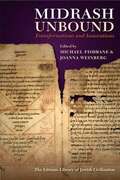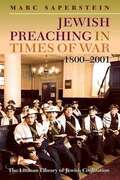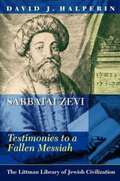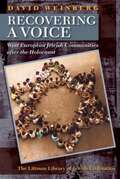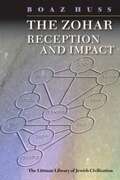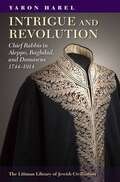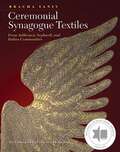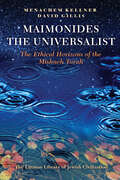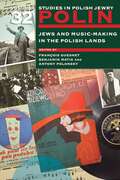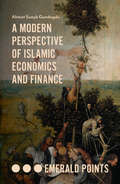- Table View
- List View
Midrash Unbound: Transformations and Innovations (The Littman Library of Jewish Civilization)
Midrash is arguably the most ancient genre of Jewish literature, forming a voluminous body of scriptural exegesis over the course of centuries. There is hardly anything in the ancient rabbinic universe that was not taught through this medium. The diversity and development of that creative profusion are presented here in a new light. The contributors cover a broad range of texts, from late antiquity to the modern period and from all the centres of literary creativity, including non-rabbinic and non-Jewish literature, so that the full extent of the modes and transformations of Midrash can be fully appreciated. A comprehensive introduction situates Midrash in its historical and cultural setting, pointing to creative adaptations within the tradition and providing a sense of the variety of genres and applications discussed in the body of the book. Bringing together an impressive array of the leading names in the field, the volume is innovative in both its scope and content, seeking to open a new period in the study of Midrash and its creative role in the formation of culture. It should be of interest to all scholars of Jewish studies, as well as to a wider readership interested in the interrelationships between hermeneutics, culture, and creativity, and especially in the afterlife of a classical genre and its ability to inspire new creativity in many forms. Contributors: Philip Alexander, Sebastian Brock, Jacob Elbaum, Michael Fishbane, Robert Hayward, William Horbury, Sara Japhet, Ephraim Kanarfogel, Naftali Loewenthal, Ivan G. Marcus, Alison Salvesen, Marc Saperstein, Chava Turniansky, Piet van Boxel, Joanna Weinberg, Benjamin Williams, Elliot Wolfson, Eli Yassif.
Gersonides: Judaism within the Limits of Reason (The Littman Library of Jewish Civilization)
by Seymour FeldmanGersonides (1288-1344), known also as Ralbag, was a philosopher of the first rank as well as an astronomer and biblical exegete, yet this is the first English-language study of the significance of his work for Jewish thought. Seymour Feldman, the acclaimed translator of Gersonides' most important work, The Wars of the Lord - a complete philosophical system and astronomical encyclopedia - has written a comprehensive picture of Gersonides' philosophy that is both descriptive and evaluative. Unusually for a Jewish scholar, Gersonides had contacts with several Christian notables and scholars. It is known that these related to mathematical and astronomical matters; the extent to which these contacts also influenced his philosophical thought is a matter of some controversy. Unquestionably, however, he wrote a veritable library of philosophical, scientific, and exegetical works that testify not only to the range of his intellectual concerns but also to his attempt to forge a philosophical-scientific synthesis between these secular sciences and Judaism.Unlike many modern scientists or philosophers, who either scorn religion or compartmentalize it, he did not see any fundamental discrepancy between the pursuit of truth via reason and its attainment through divine revelation: there is only one truth, with which both reason and revelation must agree. As a philosopher-scientist and biblical exegete Gersonides sought to make this agreement robustly evident. While philosophical and scientific ideas have progressed since Gersonides' time, his work is still relevant today because his attempt to make prophecy and miracles understandable in terms of some commonly held philosophical or scientific theory is paradigmatic of a religion that is not afraid of reason. His general principle that reason should function as a 'control' of what we believe has interesting and important implications for the modern reader. Indeed, some of his basic arguments are favoured by many contemporary thinkers who attempt to incorporate modern science into their religious belief system.He was not afraid to make religious beliefs philosophically and scientifically credible; one could say that he pursued an 'ethics of belief' in that he held that there are constraints to what is believable, especially in religion. In this respect he was a precursor of Kant and Hermann Cohen: Judaism is or should be a religion of reason.
Jewish Preaching in Times of War, 1800 - 2001 (The Littman Library of Jewish Civilization)
by Marc SapersteinWartime sermons reveal how Jews perceive themselves in relation to the majority society and how Jewish and national values are reconciled when the fate of a nation is at stake. They also illustrate how rabbis guide their communities through the challenges of their times. The sermons reproduced here were delivered by American and British rabbis from across the Jewish spectrum—Orthodox to Liberal, Ashkenazi and Sephardi—from the Napoleonic Wars to the attacks of 9/11. Each sermon is prefaced by a comprehensive introduction explaining the context in which it was delivered. Detailed notes explain allusions unfamiliar to a present-day readership and draw comparisons where appropriate to similar passages in contemporary newspapers and other sermons. A general introduction surveys more broadly the distinctive elements of modern Jewish preaching—the new preaching occasions bound up with the history of the countries in which Jews were living; new modes for the dissemination of the sermons (printed pamphlets and the Jewish and general press), and the emergence of women’s voices from the pulpit. It also surveys the distinctive themes of modern Jewish sermons, including responses to Jewish suffering, social justice, eulogies for national leaders, Zionism, and war. What Jewish religious leaders said to their congregations when their countries went to war (or, in some cases, were considering going to war) raises questions of central significance for both modern Jewish history and religious thinking in the civic context. What evidence do these sermons present concerning the degree of patriotism felt by Jews? Where and when do we find examples of dissent from the policies taken by their governments, or explicit criticism? What theological problems are raised by the preachers in the context of unprecedented and unimagined destruction, and how do they respond to these problems? How is the enemy presented in these texts? How is the problem of Jews fighting and killing other Jews addressed? Are the preachers functioning to articulate traditions that challenge the consensus of the moment, or as instruments of social control serving the needs of governments looking for unquestioning support from their citizenry? In all these areas, this book makes an important contribution to the American- and Anglo-Jewish history of this period while also making available a collection of mostly unknown Jewish texts produced at dramatic moments of the past two centuries.
Sabbatai Zevi: Testimonies to a Fallen Messiah (The Littman Library of Jewish Civilization)
by David HalperinSabbatai Zevi (1626–76) stirred up the Jewish world of the mid-seventeenth century by claiming to be the messiah, then stunned it by suddenly converting to Islam. His story, and that of the movement he created, is a landmark event in early modern Jewish history and a dramatic example of what can happen when mystic dreams and messianic hopes combine in an explosive mixture. Now, for the first time, English readers can experience these events through the words of those who lived through them, in lucid and compelling translations by a leading authority in the field. Of the contemporary ‘testimonies’ translated by David J. Halperin, three are accounts by Sabbatai Zevi’s followers of the life and deeds of their messiah. These are the Najara Chronicle, an eyewitness narrative which Gershom Scholem called ‘one of the most extraordinary documents shedding light on Sabbatai’s personality’; Baruch of Arezzo’s Memorial to the Children of Israel, a sober yet devout biography of Sabbatai written shortly after his death; and the bizarrely fanciful hagiography composed in 1692 by Abraham Cuenque of Hebron. These narratives by Sabbatean ‘believers’ are supplemented by two seventeenth-century letters, pungent in their style and colourful in their details, in which Sabbatai and his followers are described by a contemporary rabbi who detested them and everything they stood for. Finally, a reminiscence of Sabbatai’s last days, preserved by one of the most independent-minded of his followers, conveys the enigma of the man who was to haunt the generations.
Recovering a Voice: West European Jewish Communities after the Holocaust (The Littman Library of Jewish Civilization)
by David WeinbergDavid Weinberg’s multi-national study focuses on the efforts by the Jews of France, Belgium, and the Netherlands to reconstruct their lives after the Second World War. These efforts have largely been ignored, perhaps because the emphasis on assisting survivors in displaced persons camps in occupied Germany, Austria, and Italy and in developing Israel as the centre of the Jewish world after the Holocaust diverted attention from the struggle by Jews in western Europe to recover their voice and sense of purpose. Weinberg attempts to set the record straight, presenting the challenges that were faced both in the national context and in the world Jewish arena and examining how they were dealt with. Weinberg begins his study by reviewing the action taken to revive Jewish communities in the three countries materially and institutionally, remodelling them as efficient, self-sustaining, and assertive bodies that could meet new challenges. With the creation of the State of Israel, Jews who stayed in western Europe had to defend their decision to do so while nevertheless showing public support for the new nation. There was also a felt need to respond quickly and effectively to any sign of antisemitism. In addition, tensions arose between Jews and non-Jews concerning wartime collaboration in deportations, and the need to memorialize Jewish victims of Nazism. The Cold War offered challenges of its own: the perceived need to exclude communist elements from communal affairs was countered by a resistance to pressures from American Jewish leaders to sever links with Jews in eastern Europe. Yet beneath the show of assertiveness Jewish life was fragile, not only because of the physical depletion of the population and of its leadership but because the Holocaust had shaken religious beliefs and affiliations and had raised questions about the value of preserving ethnic and religious identity. At the same time, new forms of Jewish consciousness had evolved, meaning that Jewish leaders had to provide for diverse educational, religious, and cultural needs. This book's comprehensive approach offers a broad and valuable addition to existing studies on the regeneration of Jewish life in individual European countries. Underscoring the similar political, cultural, social, and economic issues facing Jewish survivors in France, Belgium, and the Netherlands after the Holocaust, David Weinberg demonstrates how, with the aid of international Jewish organizations, they used unprecedented means to meet unprecedented challenges. It is a story worth telling that adds much to our understanding of postwar European Jewish life.
The Zohar: Reception and Impact (The Littman Library of Jewish Civilization)
by Boaz HussNational Jewish Book Awards Finalist for the Nahum N. Sarna Memorial Award for Scholarship, 2016.From its first appearance, the Zohar has been one of the most sacred, authoritative, and influential books in Jewish culture. Many scholarly works have been dedicated to its mystical content, its literary style, and the question of its authorship. This book focuses on different issues: it examines the various ways in which the Zohar has been received by its readers and the impact it has had on Jewish culture, including the fluctuations in its status and value and the various cultural practices linked to these changes. This dynamic and multi-layered history throws important new light on many aspects of Jewish cultural history over the last seven centuries. Boaz Huss has broken new ground with this study, which examines of the reception and canonization of the Zohar as well as its criticism and rejection from its inception to the present day. His underlying assumption is that the different values attributed to the Zohar are not inherent qualities of the zoharic texts, but rather represent the way it has been perceived by its readers in different cultural contexts. He therefore considers not only the attribution of different qualities to the Zohar through time but also the people who were engaged in attributing such qualities and the social and cultural functions associated with their creation, re-creation, and rejection. For each historical period from the beginning of Zohar scholarship to the present, Huss considers the social conditions that stimulated the veneration of the Zohar as well as the factors that contributed to its rejection, alongside the cultural functions and consequences of each approach. Because the multiple modes of the reception of the Zohar have had a decisive influence on the history of Jewish culture, this highly innovative and wide-ranging approach to Zohar scholarship will have important repercussions for many areas of Jewish studies.
Intrigue and Revolution: Chief Rabbis in Aleppo, Baghdad, and Damascus, 1774-1914 (The Littman Library of Jewish Civilization)
by Yaron HarelThis is a book of unexpected drama: all eleven chief rabbis appointed in this period of unprecedented change in the Jewish communities of the Fertile Crescent became the subject of controversy and were subsequently dismissed. This took place against a background of events rarely discussed in the context of Jewish society: crime, hooliganism, slander, power struggles, sexual promiscuity, and even assaults and assassination attempts on rabbis. Using a wide range of testimonies gleaned from Ottoman Jewish, Arabic, and European sources, Yaron Harel paints a colourful picture of these upheavals set firmly in the social and political context of the time and far removed from the commonly accepted image of Jewish communities in the Ottoman empire. Jews were also affected by modernization and political conflict in the wider society of the time, and these too gave rise to power struggles. The chief rabbis were at the forefront of these confrontations, especially those that resulted from the new inclination towards Western culture. Most of them recognized that the challenges of modernization had to be met, although in a way that did not endanger religious principles. Their openness to change stemmed from a concern for the future of the communities for which they were responsible, but they were often vociferously opposed by those who were free from such responsibility. The communal politics that ensued were sometimes heated to the point of violence. In the latter years of the empire, many Jews came to support the Young Turks, with their promise of liberty and equality for all. The atmosphere of the time was such that rabbis had to develop political awareness and engage in Ottoman politics. This was another source of tension within the community since the new regime punished anyone suspected of opposition severely.This lively and fascinating study based on little-known sources offers a lens through which to view the Jewish society of the Ottoman empire at a time when all the traditional norms were being challenged.
Reinventing Maimonides in Contemporary Jewish Thought (The Littman Library of Jewish Civilization)
by James Diamond Menachem KellnerEvery work on Jewish thought and law since the twelfth century bears the imprint of Maimonides. A. N. Whitehead’s famous dictum that the entire European philosophical tradition ‘consists of a series of footnotes to Plato’ could equally characterize Maimonides’ place in the Jewish tradition. The critical studies in this volume explore how Orthodox rabbis of different orientations—Shlomo Aviner, Naftali Zvi Yehudah Berlin (Netziv), Kalonymus Kalman Shapira, Joseph Kafih, Abraham Isaac Kook, Aaron Kotler, Joseph Soloveitchik, and Elhanan Wasserman—have read and provided footnotes to Maimonides in the long twentieth century. How well did they really understand Maimonides? And where do their arguments fit in the mainstream debates about him and his works? Each of the seven core chapters examines a particular approach. Some rabbis have tried to liberate themselves from the influence of his ideas. Others have sought to build on those ideas or expand them in ways which Maimonides himself did not pursue, and which he may well not have agreed with. Still others advance patently non-Maimonidean positions, while attributing them to none other than Maimonides. Above all, the essays published here demonstrate that his legacy remains vibrantly alive today.
Ceremonial Synagogue Textiles: From Ashkenazi, Sephardi, and Italian Communities (The Littman Library of Jewish Civilization)
by Bracha YanivNational Jewish Book Awards 2019 Finalist for Visual Arts. Richly illustrated and meticulously documented, this is the first comprehensive survey of synagogue textiles to be available in English. Bracha Yaniv, a leading expert in the field of Jewish ceremonial textiles, records their evolution from ancient times to the present. The volume contains a systematic consideration of the mantle, the wrapper, the Torah scroll binder, and the Torah ark curtain and valance, and considers the cultural factors that inspired the evolution of these different items and their motifs. Fabrics, techniques, and modes of production are described in detail; the inscriptions marking the circumstances of donation are similarly subjected to close analysis. Fully annotated plates demonstrate the richness of the styles and traditions in use in different parts of the Jewish diaspora, drawing attention to regional customs. Throughout, emphasis is placed on presenting and explaining all relevant aspects of the Jewish cultural heritage. The concluding section contains transcriptions, translations, and annotations of some 180 inscriptions recording the circumstances in which items were donated, providing a valuable survey of customs of dedication. Together with the comprehensive bibliography, inventory lists, and other relevant documentation, this volume will be an invaluable reference work for the scholarly community, museum curators, and others interested in the Jewish cultural heritage.
Medieval Jews and the Christian Past: Jewish Historical Consciousness in Spain and Southern France (The Littman Library of Jewish Civilization)
by Ram Ben-ShalomThe historical consciousness of medieval Jewry has engendered lively debate in the scholarly world. The focus in this book is on the historical consciousness of the Jews of Spain and southern France in the late Middle Ages, and specifically on their perceptions of Christianity and Christian history and culture. In his detailed analysis of Jews’ understanding of the history of the communities they lived among, Ram Ben-Shalom shows that in these southern European lands Jews experienced a relatively open society that was sensitive to and knowledgeable about voices from other cultures, and that this had significant consequences for shaping Jewish historical consciousness. Among the topics that receive special attention are what Jews knew of the significance of Rome, of Jesus and the early days of Christianity, of Church history, and of the history of the Iberian monarchies. Ben-Shalom demonstrates that, despite the negative stereotypes of Jewry prevalent in Christian literature and increasing familiarity with that literature, they were more influenced by their interactions with Christian society at the local level. Consequently there was no single stereotype that dominated Jewish thought, and frequently little awareness of the two societies as representing distinct cultures. This book contributes to medieval Jewish intellectual history on many levels, demonstrating that, in Spain and southern France, Jews of the later Middle Ages evinced a genuine interest in history, including the history of non-Jews, and that in some cases they were deeply familiar with Christian and sometimes also classical historiography. In providing a comprehensive survey of the multiple contexts in which historiographical material was embedded and the many uses to which it was put, it enriches our understanding of medieval historiography, polemic, Jewish-Christian relations, and the breadth of interests characterizing Provencal and Spanish Jewish communities.
Reading Maimonides' Mishneh Torah (The Littman Library of Jewish Civilization)
by David GillisIn this highly original study, David Gillis demonstrates that the Mishneh torah, Maimonides’ code of Jewish law, has the structure of a microcosm. Through this symbolic form, Maimonides presents the law as designed to perfect the individual and society by shaping them in the image of the divinely created cosmic order. The commandments of the law thereby bring human beings closer to fulfilling their ultimate purpose, knowledge of God. This symbolism turns the Mishneh torah into an object of contemplation that itself communicates such knowledge. In short, it is a work of art. Gillis unpacks the metaphysical and cosmological underpinnings of Maimonides’ scheme of organization with consummate skill, allowing the reader to understand the Mishneh torah’s artistic dimension and to appreciate its power. Moreover, as he makes clear, uncovering this dimension casts new light on one of the great cruxes of Maimonides studies: the relationship of the Mishneh torah to his philosophical treatise The Guide of the Perplexed. A fundamental unity is revealed between Maimonides the codifier and Maimonides the philosopher that has not been fully appreciated hitherto. Maimonides’ artistry in composition is repeatedly shown to serve his aims in persuading us of the coherence and wisdom of the halakhic system. Gillis’s fine exegesis sets in high relief the humane and transcendental purposes and methods of halakhah as Maimonides conceived of it, in an argument that is sure-footed and convincing.
Leadership and Conflict: Tensions in Medieval and Modern Jewish History and Culture (The Littman Library of Jewish Civilization)
by Marc SapersteinThis masterly collection of essays offers a multifaceted analysis of how Jewish leaders in medieval and early modern times responded to the challenges presented by a changing world. Based largely on the study of sermons and response - genres that show them addressing real situations in the lives of their people - the book reveals how they handled intellectual, social, and political diversity and conflict. As medieval Jews were exposed to new philosophical ideas, many began to question and challenge rabbinical leadership. Leadership and Conflict explores the process by which these ideas became more accessible, the doubts that consequently arose regarding certain biblical and rabbinic texts, and the attempt by some leaders to ban the study of philosophical texts altogether. The book also addresses the rhetoric of rebuke used by preachers to criticize behavior within their community that they considered to be a violation of Jewish law and tradition. Another set of challenges to traditional Jewish life emerged from political developments in the wider world, including the unification of France, the Spanish Inquisition and Edict of Expulsion, and the beginning of the Counter-Reformation. Leadership and Conflict asks whether criticism of the talent and leadership of rabbis in such times of crisis was justified. The final section of the book is devoted to conflicting attitudes within Jewish society: towards the Holy Land, exile and diasporic existence, and messianic movements and personalities. Leadership and Conflict represents three decades of scholarship by Professor Marc Saperstein, a distinguished historian. Bringing his perceptive essays together in a single volume allows a new generation of students and scholars to have access to his insights and conclusions.
Undercurrents of Jewish Prayer (The Littman Library of Jewish Civilization)
by Jeremy SchonfieldTraditional Jews encounter the prayer-book—the Siddur—more often in their daily lives than any other text, yet it is mysteriously absent from their otherwise nearly comprehensive curriculum of study. In addition, they tend to recite it mantrically, more for its sound than its meaning. The neglect of meaning is so complete that no edition of the prayer-book has yet appeared with a comprehensive range of commentaries. The present work, the first to examine this paradox, explains it as a reluctance to engage with the intellectual and emotional questions that lie just beneath the surface of the text. An analysis of the opening sequences of the daily ritual reveals that the prayer-book, far from representing one side of a deferential dialogue with an attentive deity, actually challenges God to allow access to the revelation on which human safety depends and to keep his side of the covenant. Confronting the chaotic unpredictability of the human condition, this undercurrent of protest allows Jews to question why God’s urgently needed intervention seems absent. Anger at this apparent absence is qualified only by gratitude at being alive. The core of this book consists of a novel examination of the opening sections of the traditional daily morning liturgy according to the Ashkenazi rite. The analysis is based on mostly untranslated medieval and later commentaries identifying the biblical and rabbinic echoes from which the liturgy is woven, and employs analytical methods of the kind traditionally applied to talmudic and midrashic texts. It shows how each citation and echo imports aspects of its original context into the new composition, forming a countertext to the words on the page. It examines each textual layer, as well as the surface meaning that is usually the only one to be noted, and relates these to the speaker’s actual location—home and later the synagogue—as well as to the time of day when the prayers are recited, as the worshipper faces the dangers of the day ahead. The resulting chorus of ideas—linking everyday life to the sacred narrative from creation to exile—demonstrates the philosophical sophistication of rabbinic spirituality in offering poetic insight into an ultimately tragic vision of reality.
Collected Essays: Volume I (The Littman Library of Jewish Civilization)
by Haym SoloveitchikWritten at different times and for different audiences - some for scholars of rabbinic literature, some for laymen or for scholars not necessarily Jewish - the essays gathered together in this volume nevertheless have an inner coherence. They reflect the author's lifetime interest in the history of halakhah - not as intellectual history per se, but rather a concern to identify measurable deflection in the unfolding of halakhic ideas that could point to an undetected force at work. What was it that stimulated change, and why? What happened when strong forces impinged upon halakhic observance, and both the scholarly elite and the community as a whole had to grapple with upholding observance while adapting to a new set of circumstances? Haym Soloveitchik's elegant presentation shows skilfully that the line between adaptation and deviance is a fine one, and that where a society draws that line is revelatory of both its values and its self-perception. Many of the articles presented here are well known in the field but have been updated for this publication (the major essay on pawnbroking has been expanded to half again its original size); some have been previously published only in Hebrew, and two are completely new. An Introduction highlights the key themes of the collection and explains the underlying methodology. Having these essays in a single volume will enable scholars and students to consult all the material on each theme together, while also tracing the development of ideas. The opening section of the volume is a brief description and characterization of the dramatis personae who figure in all these essays: Rashi and the Tosafists. It covers the halakhic commentaries and their authors; the creativity of Ashkenaz; and the halakhic isolation of the Ashkenazic community. The second section focuses on usury and money-lending, including the practice of pawn-broking, while the third section deals with the ban on Gentile wine and how that connected to the development of money-lending. The final section presents general conclusions in the form of four studies of the communal self-image of Ashkenaz and its attitude to deviation and change.
Collected Essays: Volume II (The Littman Library of Jewish Civilization)
by Haym SoloveitchikIn this second volume of his essays on the history of halakhah, Haym Soloveitchik grapples with much-disputed topics in medieval Jewish history and takes issue with a number of reigning views. His insistence that proper understanding requires substantive, in-depth analysis of the sources leads him to a searching analysis of oft-cited halakhic texts of Ashkenaz, frequently with conclusions that differ from the current consensus. Medieval Jewish historians cannot, he argues, avoid engaging in detailed textual criticism, and texts must always be interpreted in the context of the legal culture of their time. Historians who shirk these tasks risk reinforcing a version that supports their own preconceptions, and retrojecting later notions on to an earlier age. These basic methodological points underlie every topic discussed. In Part I, devoted to the cultural origins of Ashkenaz and its lasting impact, Professor Soloveitchik questions the scholarly consensus that the roots of Ashkenaz lie deep in Palestinian soil. He challenges the widespread notion that it was immemorial custom (minhag kadmon) that primarily governed Early Ashkenaz, the culture that emerged in the Rhineland in the late tenth century and which was ended by the ravages of the First Crusade (1096). He similarly rejects the theory that it was only towards the middle of the eleventh century that the Babylonian Talmud came to be regarded as fully authoritative. On the basis of an in-depth analysis of the literature of the time, he shows that the scholars of Early Ashkenaz displayed an astonishing command of the complex corpus of the Babylonian Talmud and viewed it at all times as the touchstone of the permissible and the forbidden. The section concludes with his own radical proposal as to the source of Ashkenazi culture and the stamp it left upon the Jews of northern Europe for close to a millennium. The second part of the volume treats the issue of martyrdom as perceived and practised by Jews under Islam and Christianity. In one of the longer essays, Soloveitchik claims that Maimonides’ problematic Iggeret ha-Shemad is a work of rhetoric, not halakhah—a conclusion that has generated much criticism from other scholars, to whom he replies one by one. This is followed by a comprehensive study of kiddush ha-shem in Ashkenaz, which draws him into an analysis of whether aggadic sources were used by the Tosafists in halakhic arguments, as some historians claim; whether there was any halakhic validation of the widespread phenomenon of voluntary martyrdom; and, indeed, whether halakhic considerations played any part in such tragic life-and-death issues. The book concludes with two essays on Mishneh torah which argue that that famed code must also be viewed as a work of art which sustains, as masterpieces do, multiple conflicting interpretations.
Lithuanian Yeshivas of the Nineteenth Century: Creating a Tradition of Learning (The Littman Library of Jewish Civilization)
by Shaul StampferOne of the key ways in which the traditional Jewish world of eastern Europe responded to the challenges of modernity in the nineteenth century was to change the system for educating young men so as to reinforce time-honoured, conservative values. The yeshivas established at that time in Lithuania became models for an educational system that has persisted to this day, transmitting the talmudic underpinnings of the traditional Jewish way of life. To understand how that system works, one needs to go back to the institutions they are patterned on: why they were established, how they were organized, and how they operated. This is the first properly documented, systematic study of the Lithuanian yeshiva as it existed from 1802 to 1914. It is based on the judicious use of contemporary sources—documents, articles in the press, and memoirs—with a view to presenting the yeshiva in its social and cultural context. Three key institutions are considered. Pride of place in the first part of the book is given to the yeshiva of Volozhin, which was founded in 1802 according to an entirely new concept—total independence from the local community—and was in that sense the model for everything that followed. Chapters in the second part focus on the yeshiva of Slobodka, famed for introducing the study of musar (ethics); the yeshiva of Telz, with its structural and organizational innovations; and the kollel system, introduced so that married men could continue their yeshiva education. Topics covered include the leadership and changes in leadership; management and administration; the yeshiva as a place of study; and daily life. This English edition is based on the second Hebrew edition, which was revised to include information that became available with the opening of archives in eastern Europe after the fall of communism.
Final Judgement and the Dead in Medieval Jewish Thought (The Littman Library of Jewish Civilization)
by Susan WeissmanThrough a detailed analysis of ghost tales in the Ashkenazi pietistic work Sefer ḥasidim, Susan Weissman documents a major transformation in Jewish attitudes and practices regarding the dead and the afterlife that took place between the rabbinic period and medieval times. She reveals that a huge influx of Germano-Christian beliefs, customs, and fears relating to the dead and the afterlife seeped into medieval Ashkenazi society among both elite and popular groups. In matters of sin, penance, and posthumous punishment, the infiltration of Christian notions was so strong as to effect a radical departure in Pietist thinking from rabbinic thought and to spur outright contradiction of talmudic principles regarding the realm of the hereafter. Although it is primarily a study of the culture of a medieval Jewish enclave, this book demonstrates how seminal beliefs of medieval Christendom and monastic ideals could take root in a society with contrary religious values—even in the realm of doctrinal belief.
Maimonides the Universalist: The Ethical Horizons of the Mishneh Torah (The Littman Library of Jewish Civilization)
by Menachem Kellner David GillisMaimonides ends each book of his legal code the Mishneh torah with a moral or philosophical reflection, in which he lifts his eyes, as it were, from purely halakhic concerns and surveys broader horizons. Menachem Kellner and David Gillis analyse these concluding paragraphs, examining their verbal and thematic echoes, their adaptation of rabbinic sources, and the way in which they coordinate with the Mishneh torah’s underlying structures, in order to understand how they might influence our interpretation of the code as a whole—and indeed our view of Maimonides himself and his philosophy. Taking this unusual cross-section of the work, Kellner and Gillis conclude that the Mishneh torah presents not only a system of law, but also a system of universal values. They show how Maimonides fashions Jewish law and ritual as a programme for attaining ethical and intellectual ends that are accessible to all human beings, who are created equally in the image of God.Many reject the presentation of Maimonides as a universalist. The Mishneh torah especially is widely seen as a particularist sanctuary. This study shows how profoundly that view must be revised.
Collected Essays: Volume III (The Littman Library of Jewish Civilization)
by Haym SoloveitchikContinuing his contribution to medieval Jewish intellectual history, Haym Soloveitchik focuses here on the radical pietist movement of Ḥasidei Ashkenaz and its main literary work, Sefer Ḥasidim, and on the writings and personality of the Provençal commentator Ravad of Posquières. In both areas Soloveitchik challenges mainstream views to provide a new understanding of medieval Jewish thought. Some of the essays are revised and updated versions of work previously published and some are entirely new, but in all of them Soloveitchik challenges reigning views to provide a new understanding of medieval Jewish thought.The section on Sefer Ḥasidim brings together over half a century of Soloveitchik’s writings on German Pietism, many of which originally appeared in obscure publications, and adds two new essays. The first of these is a methodological study of how to read this challenging work and an exposition of what constitutes a valid historical inference, while the second reviews the validity of the sociological and anthropological inferences presented in contemporary historiography. In discussing Ravad’s oeuvre, Soloveitchik questions the widespread notion that Ravad’s chief accomplishment was his commentary on Maimonides’ Mishneh torah; his Talmud commentary, he claims, was of far greater importance and was his true masterpiece. He also adds a new study that focuses on the acrimony between Ravad, as the low-born genius of Posquières, and R. Zerahyah ha-Levi of Lunel, who belonged to the Jewish aristocracy of Languedoc, and considers the implications of that relationship.
Conscious History: Polish Jewish Historians before the Holocaust (The Littman Library of Jewish Civilization)
by Natalia AleksiunThoroughly researched, this study highlights the historical scholarship that is one of the lasting legacies of interwar Polish Jewry and analyses its political and social context. As Jewish citizens struggled to assert their place in a newly independent Poland, a dedicated group of Jewish scholars fascinated by history devoted themselves to creating a sense of Polish Jewish belonging while also fighting for their rights as an ethnic minority. The political climate made it hard for these men and women to pursue an academic career; instead they had to continue their efforts to create and disseminate Polish Jewish history by teaching outside the university and publishing in scholarly and popular journals. By introducing the Jewish public to a pantheon of historical heroes to celebrate and anniversaries to commemorate, they sought to forge a community aware of its past, its cultural heritage, and its achievements---though no less important were their efforts to counter the increased hostility towards Jews in the public discourse of the day. In highlighting the role of public intellectuals and the social role of scholars and historical scholarship, this study adds a new dimension to the understanding of the Polish Jewish world in the interwar period.
Hasidism Beyond Modernity: Essays in Habad Thought and History (The Littman Library of Jewish Civilization)
by Naftali LoewenthalThe Habad school of hasidism is distinguished today from other hasidic groups by its famous emphasis on outreach, on messianism, and on empowering women. Hasidism Beyond Modernity provides a critical, thematic study of the movement from its beginnings, showing how its unusual qualities evolved. Topics investigated include the theoretical underpinning of the outreach ethos; the turn towards women in the twentieth century; new attitudes to non-Jews; the role of the individual in the hasidic collective; spiritual contemplation in the context of modernity; the quest for inclusivism in the face of prevailing schismatic processes; messianism in both spiritual and political forms; and the direction of the movement after the passing of its seventh rebbe, Rabbi Menachem Mendel Schneerson, in 1994. Attention is given to many contrasts: pre-modern, modern, and postmodern conceptions of Judaism; the clash between maintaining an enclave and outreach models of Jewish society; particularist and universalist trends; and the subtle interplay of mystical faith and rationality. Some of the chapters are new; others, published in an earlier form, have been updated to take account of recent scholarship. This book presents an in-depth study of an intriguing movement which takes traditional hasidism beyond modernity.
Polin: Jews and Music-Making in the Polish Lands (Polin: Studies in Polish Jewry #32)
With its five thematic sections covering genres from cantorial to classical to klezmer, this pioneering multi-disciplinary volume presents rich coverage of the work of musicians of Jewish origin in the Polish lands. It opens with the musical consequences of developments in Jewish religious practice: the spread of hasidism in the eighteenth century meant that popular melodies replaced traditional cantorial music, while the greater acculturation of Jews in the nineteenth century brought with it synagogue choirs. Jewish involvement in popular culture included performances for the wider public, Yiddish songs and the Yiddish theatre, and contributions of many different sorts---technical and commercial as well as creative---in the interwar years. Chapters on the classical music scene cover Jewish musical institutions, organizations, and education; individual composers and musicians; and a consideration of music and Jewish national identity. One section is devoted to the Holocaust as reflected in Jewish music, and the final section deals with the afterlife of Jewish musical creativity in Poland, particularly the resurgence of interest in klezmer music. The essays in this collection do not attempt to to define what may well be undefinable---what ‘Jewish music’ is. Rather, they provide an original and much-needed exploration of the activities and creativity of ‘musicians of the Jewish faith’.CONTRIBUTORS: Eliyana R. Adler, Michael Aylward, Sławomir Dobrzański, Paula Eisenstein-Baker, Beth Holmgren, Sylwia Jakubczyk-Ślęczka, Daniel Katz, James Loeffler, Michael Lukin, Filip Mazurczak, Bożena Muszkalska, Julia Riegel, Ronald Robboy, Robert Rothstein, Joel E. Rubin, Adam J. Sacks, Amanda (Miryem-Khaye) Seigel, Eleanor Shapiro, Carla Shapreau, Tamara Sztyma, Bella Szwarcman-Czarnota, Joseph Toltz, Maja Trochimczyk, Magdalena Waligórska, Bret Werb, Akiva Zimmerman
Research in Corporate and Shari'ah Governance in the Muslim World: Theory and Practice
by Toseef Azid Ali Abdullah Alnodel Muhammad Azeem QureshiCorporate governance is oriented around the values of fairness, transparency and accountability. The comprehension and measurement of these objectives is subject to the social and economic attributes of the corporate arena. Significant bodies of intellectual work have approached an assessment of corporate governance from perspectives such as differences in management practices, economic advancements, financial management, as well as regional and country constituents. But little is known about the Islamic perspective on the conceptualization, structure and practice of corporate governance. Research in Corporate and Shari'ah Governance in the Muslim World: Theory and Practice aims to address a critical disciplinary gap between Islamic theory and the practice of the corporate sector in the Muslim World. Adopting a critical approach, the book sheds light on the impact of corporate governance on the economies of the Muslim world. It presents an examination of: Corporate governance in Islamic financial institutions The efficiency of the Islamic Jurisprudence system The common conceptual grounds of corporate structure in the Muslim World The composition of business leaders in the Muslim World Using standard tools of analysis, the book presents a logically consistent synthesis of key variables with critical economic reasoning. It extends the conventional scope of corporate governance to form a basis for common understanding of how it operates in the Muslim world. The book will prove useful to those who research, study and practice in this field.
Research in Corporate and Shari'ah Governance in the Muslim World: Theory and Practice
by Toseef Azid Ali Abdullah Alnodel Muhammad Azeem QureshiCorporate governance is oriented around the values of fairness, transparency and accountability. The comprehension and measurement of these objectives is subject to the social and economic attributes of the corporate arena. Significant bodies of intellectual work have approached an assessment of corporate governance from perspectives such as differences in management practices, economic advancements, financial management, as well as regional and country constituents. But little is known about the Islamic perspective on the conceptualization, structure and practice of corporate governance. Research in Corporate and Shari'ah Governance in the Muslim World: Theory and Practice aims to address a critical disciplinary gap between Islamic theory and the practice of the corporate sector in the Muslim World. Adopting a critical approach, the book sheds light on the impact of corporate governance on the economies of the Muslim world. It presents an examination of: Corporate governance in Islamic financial institutions The efficiency of the Islamic Jurisprudence system The common conceptual grounds of corporate structure in the Muslim World The composition of business leaders in the Muslim World Using standard tools of analysis, the book presents a logically consistent synthesis of key variables with critical economic reasoning. It extends the conventional scope of corporate governance to form a basis for common understanding of how it operates in the Muslim world. The book will prove useful to those who research, study and practice in this field.
A Modern Perspective of Islamic Economics and Finance (Emerald Points)
by Ahmet Suayb GundogduTraditionally, academic reflections on Islamic economics and finance have relied on a misleading understanding of Maqasid Al-Shari’ah. Much of the current research on the subject dogmatically adheres to the teachings of classical Islamic philosophers and does not appeal to practitioners of economics and finance who are looking for guidance on practical application rather than academic verbosity. This book aims to develop a blueprint for Islamic economics and finance by starting at the grass roots of trade and commerce. The majority of the world population, both in developed countries and emerging markets, have serious concerns over financial sustainability for themselves or their children. Islamic finance is meant to support an economy through genuine transactions and fulfil a duty to achieve a fair and prosperous society. Unfortunately, the industry has failed to fulfil this proposition and converged to conventional systems that do not link to the wider economic priorities of Islam. This book positions Islamic finance within the economic priorities of Islam while providing a cohesive understanding of Islamic economics and finance in a clear and practical manner. In doing so, the book provides the to-dos and not-to-dos of Islamic economics and finance, and instigates an Islamic monetary system in which people, not central banks, create money as long as they produce things demanded by other people.
